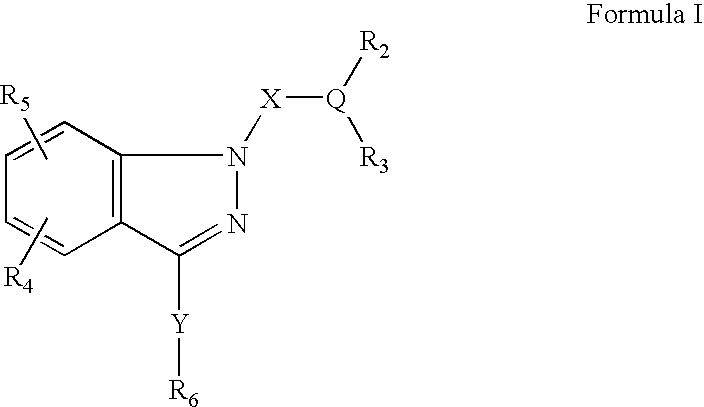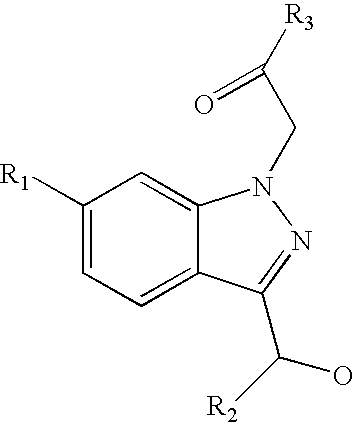Ophthalmic compositions for treating ocular hypertension
a technology of ocular hypertension and compositions, applied in the direction of drug compositions, biocide, cardiovascular disorders, etc., can solve the problems of irreversible loss of visual function, unsatisfactory side effects, and unsatisfactory efficacy of these agents
- Summary
- Abstract
- Description
- Claims
- Application Information
AI Technical Summary
Benefits of technology
Problems solved by technology
Method used
Image
Examples
example 2
Preparative Example 2
[0110]
10 g of benzylnitrile derivative was dissolved in THE 20 mL followed by dilution with 50 mL of methanol. The reaction mixture was taken in a pressure tube, Pd—C (10% wt / 10 mole %) was added and the reaction mixture was hydrogenated at 40 psi. After the requisite amount of hydrogen for the reduction of the NO2 group was consumed the reaction was stopped. TLC analysis indicated a spot to spot convenrsion. The reaction mixture was filtered over a pad of celite and the filtrate was concentrated to a solid and used in the next step directly. Crude aniline derivative (52 mmoles was dissloved / suspended in 2N HCl (150 mL), cooled to 5° C. followed by the addition of 5.4 g of sodium nitrite in 10 mL of water. The reaction mixture was allowed to stir for 1 h with gradual warming to room temperature. TLC analysis indicated complete consumption of SM(starting material) and the formation of a new spot. The reaction mixture was extracted with ethyl acetate (100 mL×4); o...
example 1
[0113]
[0114]Benzoyl derivative (8.6 mmoles, obtained from Preparative Example 3) was dissolved in 8 mL of DMF followed by the addition of 1.2 equiv. of NaH (60% solution in mineral oil). After stirring at room temperature for 15 min 1.5 equiv. of methyl bromoacetate was added and the reaction mixture was stirred for additional 0.5 h. TLC analysis indicated completion of reaction. Standard aqueous work-up followed by SGC purification of the crude material gave 2.2 grams of desired acetate derivative. Hydrolysis of the methyl ester was carried out using LiOH. Ester (2.2 g; 6.8 mmoles) was dissolved in 100 mL of THF followed by the addition of 1M LiOH (15 mL). The reaction was complete in 0.5 h according to TLC and LCMS. Acidification by addition of 15 mL of 1N HCl followed by extraction with ethyl acetate and evaporation of solvent gave solid residue which was 95% pure by HPLC and suitable to be used in the coupling step. LCMS [M+H]=311Example 2
[0115]
[0116]Acid (300 mg from Example 1)...
example 3
[0118]
[0119]LCMS [M+H]=420
EXAMPLE 4
[0120]
[0121]LCMS [M+H]=394
EXAMPLE 5
[0122]
[0123]LCMS [M+H]=418
EXAMPLE 6
[0124]
EXAMPLE 7
[0125]
[0126]LCMS [M+H]=366
EXAMPLE 8
[0127]
[0128]LCMS [M+H]=393
EXAMPLE 9
[0129]
[0130]LCMS [M+H]=407
EXAMPLE 10
[0131]
[0132]LCMS [M+H]=447
EXAMPLE 11
[0133]
[0134]Weighed out 4.15 g of indazole (compound e, Preparative Example 2) and azeoptroped water with 2 toluene (100 ml) washings, pulling off toluene azeotrope by rotovap. Dried thoroughly under high vacuum and performed argon purges. Dissolved in 40 ml dry THF and 92 ml dry ether under argon. Cooled to 5° C. in ice water bath. Charged 3 eq of isopropylmagnesium chloride (36 ml of a 2M solution in THF) and stired for 0.5 hour at room temp. Carefully charged 1N HCl (240 ml) and stired for 1 h. Monitored reaction by LC. Extracted with EtOAc, rotovaped to provided compound f. LCMS [M+H]=219
[0135]Starting Material (3.40 g, Compound f) was weighed out into flask and dried with toluene (100 ml) and azeotrope removed by rotovap...
PUM
| Property | Measurement | Unit |
|---|---|---|
| temperature | aaaaa | aaaaa |
| pH | aaaaa | aaaaa |
| temperature | aaaaa | aaaaa |
Abstract
Description
Claims
Application Information
 Login to View More
Login to View More - R&D
- Intellectual Property
- Life Sciences
- Materials
- Tech Scout
- Unparalleled Data Quality
- Higher Quality Content
- 60% Fewer Hallucinations
Browse by: Latest US Patents, China's latest patents, Technical Efficacy Thesaurus, Application Domain, Technology Topic, Popular Technical Reports.
© 2025 PatSnap. All rights reserved.Legal|Privacy policy|Modern Slavery Act Transparency Statement|Sitemap|About US| Contact US: help@patsnap.com



